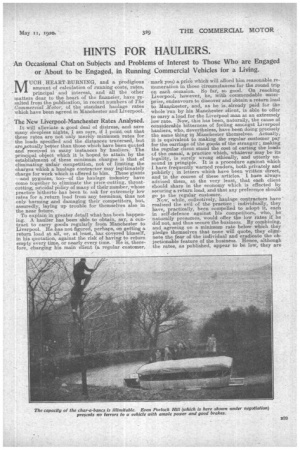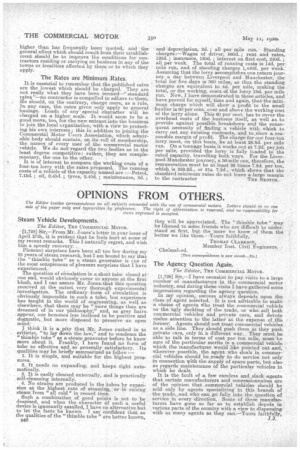HINTS FOR HAULIERS.
Page 25

Page 26

If you've noticed an error in this article please click here to report it so we can fix it.
An Occasional Chat on Subjects and Problems of Interest to Those Who are Engaged or About to be Engaged, in Running Commercial Vehicles for a Living.
MUCH , HEART-BURNING, and a, prodigious amount of calculation of running costs, rates, principal and interest, and all the other • matters dear to the heart of the financier, have resulted from the publication, in recent numbers of The ,Commercial Motor, of the standard haulage rates which have been agreed in Manchester and Liverpool.
The New Liverpool-Manchester Rates Analysed.
It will alleviate a good deal of distress, and save many sleepless nights, I am sure, if I point out that these rates are not only merely minimum rates for the loads specified and the distances traversed, but are _actually better than these which have been quoted and received in many instances by hauliers. The principal. object which it is hoped to attain by the establishment of these minimum charges is that of eliminating unfair competition, not of limiting the charges which a haulage contraetor may legitimately charge for work which is offered to him. These giants —and pygmies, too—of the haulage industry have come together to eliminate the price-cutting, throatcutting, suicidal Policy of many of their number, whose practice hitherto has been tc ask for extremely low rates for a return load from any terminus, thus not only harming and damaging their competitors, but, assuredly, laying up trouble for themselves also in the near future.
To explain,in greater detail whathas been happening. A haulier has been able to obtain, say, a. contract to carry goods regularly from Manchester to Liverpool. He has not figured, perhaps, on getting a return load at all, or, at least, has covered himself, in his quotation, against the risk of having to return empty every time, or nearly every time. He is, therefore, charging his main client (a. regular customer, mark you) a price which will afford him reasonable remuneration in those -circumstances for the round trip on each occasion. So faf, so good. On reaching Liverpool, however, he, with commendable enterprise, endeavours to discover and obtain a return load to Manehester, and, as he is_alrearly paid fer the whole run by his Manchester client, is able to offer to carry a. load for the Liverpool man at an extremely law rate. Now, this has been, naturally, the cause of considerable bitterneas of feeling amongst Liverpool hauliers, who, nevertheless, have been doing precisely the same thing in. Manchester themselves. Actually, it is equivalent to making the regular customer pay for the earria,ge of the goods of the stranger ; making the regular client stand the cost of carting the loads cf the casual, a practace which, whatever may be its legality, is surely wrong ethically, and utterly unsound in principle. It is a procedure against which I have frequently warned readers, both privately and publicly ; in letters which have been written direct, and in the course of these articles.I have always advised them, at the very least, that each client should share in the economy which is effected by securing a return load, and that any preference should
go to the regular customer.
Ncw, while, collectively, haulage contractors have • realized the evil of the practice ; indrvidua.11y, they have, practically, been compelled to adopt it, each in self-defence against his competitors, who, , he naturally presumes, would offer the law rates if he did not, and thus secure the businese. By combining, and agreeing on a minimum rate below which they pledge themselves tha,t none will quotes they eliminate the fear of the individual and eradicate the objectionable feature of the business. Hence, although the rates, as published, appear to be low, they are higher than has frequently been quoted,and the general effect which should result from their establishment should be to improve the conditions for contractors residing or carrying on business in any of the towns or localities affected by them or to which they apply.
The Rates are Minimum Rates.
It is essential to remember that the published rates are the lowest which should be charged. They are not really. what they have been termed—" standard rates "—no contractor is compelled to adhere to them. Ile should, on the contrary, charge more, as a, rule. In any ease, the rates given only apply to general haulage. Loads of any special character will be charged on a. higher scale. It would seem to be a good move, too, for the new, entrant into the business to join the local organization, with a, view to protecting his own interests this in addition to joining the Commercial Motor Users Association, which admirable body should contain, on its roll of membership, the names of every user of the commercial motor vehicle. We do not-regard the two bodies as in the least degree competitive: rather, they are complementary, the one to the other.
It is of interest to compare the wurking costs of a four-ton lorry with the rates proposed. The running costs of a vehicle of the capacity riamed are :--Petrol, 7.15d. ; oil, 0.45d. e tyres, 2.40d. ; maintenance, 2d. ; and depreciation, 2d.; all per mile .run. Standing charges :—Wagea of driver, 960d.; rent and rates, 120d.; insurance, 120d.; interest on first cost, 240.d. ; all per week. The total of running costs is 14d. per mile run, and of standing charges 1,440d. per week.Assuming that the lorry accomplishes one return journey a day between Liverpool and Manchester, the total for five days is 360 mike, so that the standing charges are equivalent to 4d. per mile, making the total, or the working, costs of the lorry 18d. per mile run. Now, I have demonstrated in these articles, and have proved for myself? time and a-gain, that the minimum charge which will show. a profit to the small haulier is 60 per cent. over and above the working cost of the lorry alone. This 60 per cent.has to cover the overhead costs of the business itself, as well as to provide against possible breakdown and the consequent necessity of finding a vehicle with .which to carry out.any.existieg contracts, and toeshow .a sea,sonahle.margin of profit. The °barge for our fourton lorry, must, on this basis, be at least 28.8d. per mile run. On a tonnage basis it works out at 7.2d. per ;ton per mile, provided the lorry is fully loaded to the rated capacity, travelling both ways. For the Liverpool-Manchester journey, a 36-mile one, therefore, the remuneration must be at least 36 times 7.2d. per ton, whioh. is 259.2d., or 21s. 7.2d., which shows that the standard painimune rates do not leave a large margin
to the contractor THE SKOTCH.,




























